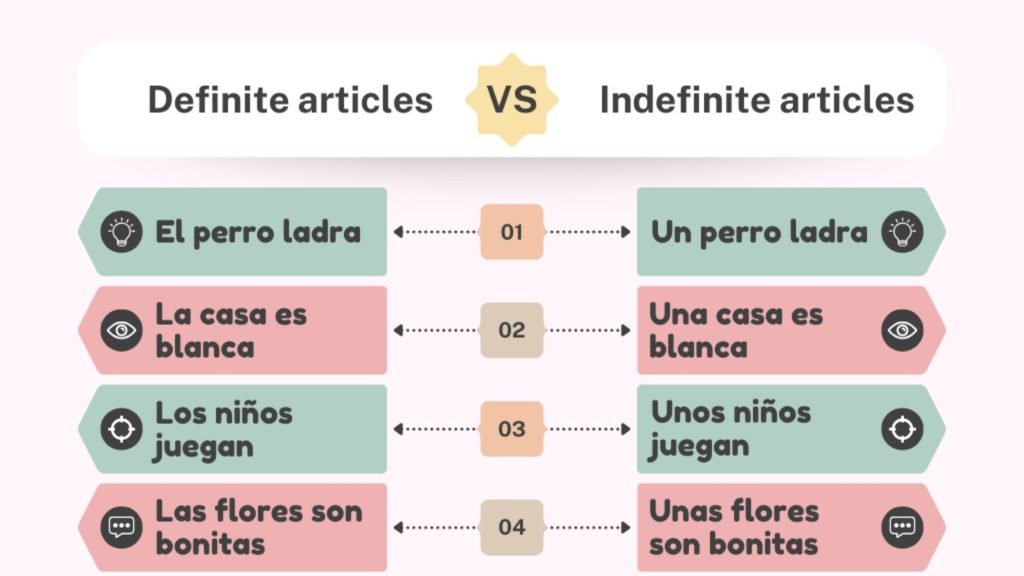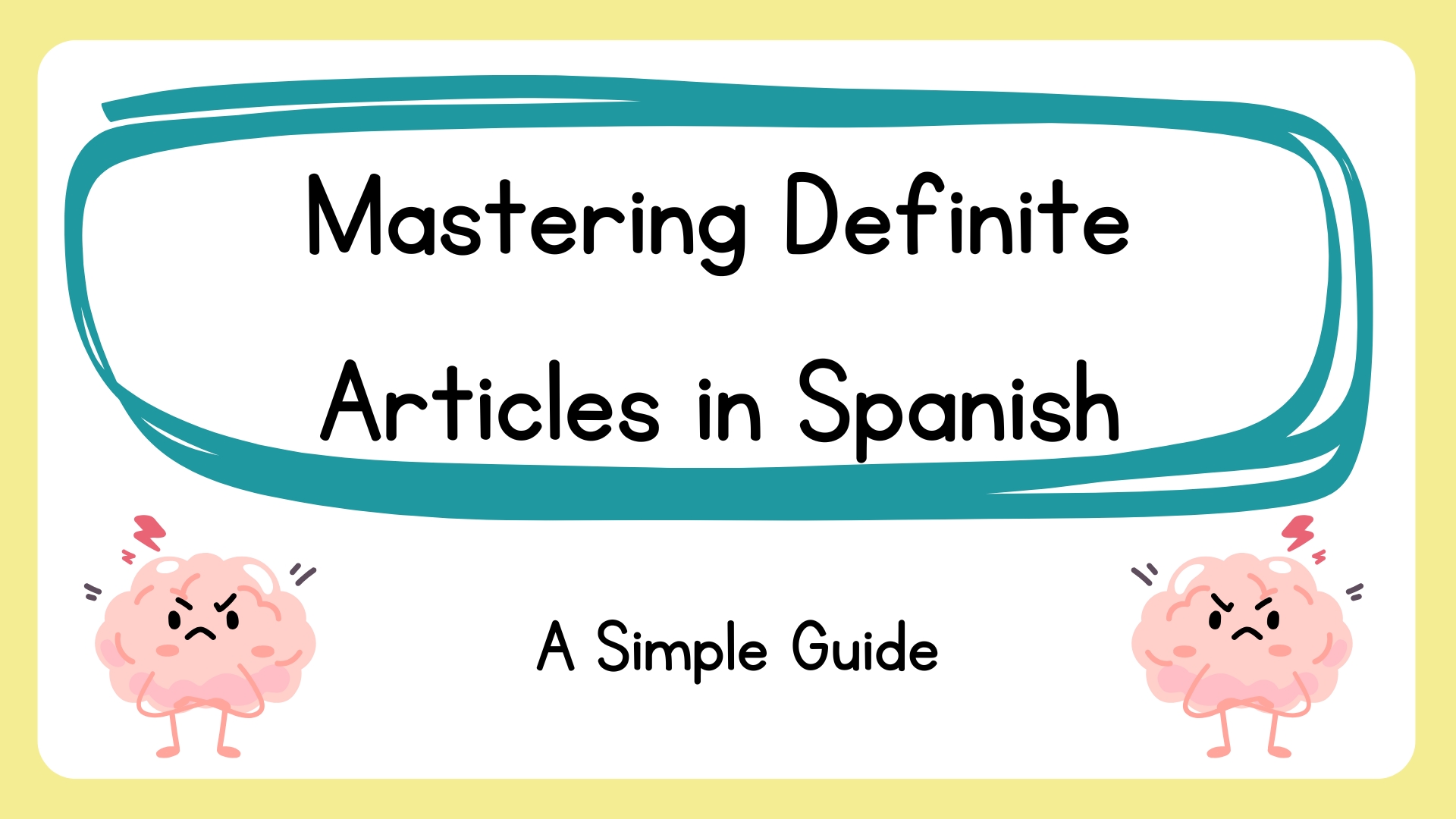When you dive into Spanish, you quickly meet its definite articles: ‘el’, ‘la’, ‘los’, and ‘las’. These little words tell you if a noun is masculine or feminine, singular or plural. They’re key in making your sentences clear, helping you point out if you’re talking about something specific or general.
What are articles in Spanish?
In Spanish, articles are small words that tell us if a noun is specific or not, and they match the noun’s gender and number. These words are really important for clear communication.
They help specify whether we’re talking about something definite or indefinite, how much of it there is, and what we mean by it. This makes the meaning clear.
In Spanish, you have two main types of articles: definite and indefinite. They change depending on whether a noun is singular or plural, and whether it’s masculine or feminine. Knowing how these articles work is key to speaking and writing Spanish well.
Let’s break it down simply. With definite articles, you’re talking about something specific. Indefinite articles, on the other hand, are more general. Plus, these articles change their form to match the gender and number of the noun they go with. It might sound tricky, but you’ll get the hang of it with a bit of practice.
Spanish definite and indefinite articles
In Spanish, we use articles to point out whether we’re talking about something specific or something more general.
| Article Type | Use Case | Examples |
|---|---|---|
| Definite | Refers to specific things | el, la, los, las |
| Indefinite | Refers to non-specific things | un, una, unos, unas |
Definite articles in singular and plural
Understanding definite articles in Spanish is pretty straightforward.
| Number | Masculine | Feminine |
|---|---|---|
| Singular | el | la |
| Plural | los | las |
When these nouns are plural, ‘el’ becomes ‘los’ and ‘la’ turns into ‘las’.
This change is crucial for speaking and writing Spanish correctly.
Definite articles in Spanish
In Spanish, the definite articles change based on whether the noun is masculine or feminine, and whether it’s singular or plural.

- When referring to something known to the speaker
- When the noun has been mentioned before
- When generalizing about a group or category
- With parts of the body or clothing
- With dates and times
Learn how to form descriptive sentences in Spanish the easy way.
Feminine noun endings
Knowing the usual endings of feminine nouns in Spanish really helps when you’re trying to use the right definite articles.
Common Feminine Endings :
- -a (casa)
- -ción (información)
- -sión (televisión)
- -dad (ciudad)
- -tad (amistad)
Let’s look at some examples:
- la casa — the house
- la información — the information
- la ciudad — the city
- la canción — the song
- la libertad — the freedom
These examples show how these endings help us decide whether to use ‘la’ or ‘las’ for feminine nouns, whether they are singular or plural.
Masculine noun endings
In Spanish, nouns ending in
- -o (libro)
- -ma (problema)
- -pa (mapa)
- -e (café)
- -or (motor)
This is important for using the right articles and making sure adjectives agree with nouns.
If you get these endings right, you’ll find it easier to form correct sentences and understand how gender affects the Spanish language.
Common Spanish noun endings
When you’re learning Spanish, it helps to know how nouns work. Typically, words that end in -a are feminine.
| Ending | Likely Gender | Example |
|---|---|---|
| -o | Masculine | zapato |
| -a | Feminine | mesa |
| -ión | Feminine | canción |
| -dad | Feminine | libertad |
| -ma | Masculine | programa |
Examples of singular and plural definite articles
In Spanish, the definite articles change based on whether the noun is masculine or feminine, and whether it’s singular or plural.
| Spanish Phrase | English Meaning |
|---|---|
| el libro | the book |
| la casa | the house |
| los libros | the books |
| las casas | the houses |
| el coche | the car |
| la flor | the flower |
| los coches | the cars |
| las flores | the flowers |
Explore our full collection of emotional and meaningful Father’s Day sayings for Mexican dads.
When to use definite articles
Knowing when to use definite articles in Spanish is key if you want to speak and write the language well.
- Talking about specific people or things
- Mentioning body parts or clothing
- Referring to abstract concepts
- Talking about days of the week in a habitual sense
Indefinite articles in singular and plural
In Spanish, definite articles point to specific things we already know about. But when we talk about things in a general way, we use indefinite articles.
| Number | Masculine | Feminine |
|---|---|---|
| Singular | un | una |
| Plural | unos | unas |
Singular and plural indefinite articles
In Spanish, indefinite articles change depending on whether the noun is singular or plural, and whether it’s masculine or feminine.
| Spanish Phrase | English Meaning |
|---|---|
| un libro | a book |
| una casa | a house |
| unos libros | some books |
| unas casas | some houses |
| un coche | a car |
| una flor | a flower |
| unos coches | some cars |
| unas flores | some flowers |
When to use indefinite articles
We’ve looked at how indefinite articles change depending on number and gender.
Now, let’s talk about when to actually use these articles in Spanish.
You use an indefinite article when you’re talking about something that’s not specific, or when you’re mentioning something for the first time.
- Introducing a person or object for the first time
- Talking about one of many
- Describing something non-specific
- With professions (with adjectives)
Differences between definite and indefinite articles in Spanish
Knowing how to use articles in Spanish really helps you get better at the language. You see, definite articles like ‘el, la, los, las’ are used when talking about specific things everyone knows about.

On the other hand, indefinite articles like ‘un, una, unos, unas’ are more general. They don’t refer to a specific item.
| Type | Focus | Examples |
|---|---|---|
| Definite | Specific, known items | el perro (the dog) |
| Indefinite | General, unknown items | un perro (a dog) |
When not to use articles in Spanish
In Spanish, you often skip the articles in specific situations, especially with some prepositions. Take ‘del’ and ‘al’ for instance—these are combinations of prepositions and articles (‘de + el’ and ‘a + el’). So, when you use them, you don’t need to add another article.
- Talking about meals (Desayuno a las 8)
- Talking about languages after hablar (Habla español)
- Using titles with names in direct address (Doctor García)
Contractions del and al
Understanding the Spanish contractions ‘del’ and ‘al’ is pretty straightforward. They show us how certain words blend together.
| Contraction | Made From | Meaning | Example |
|---|---|---|---|
| del | de + el | of the | El color del coche |
| al | a + el | to the | Vamos al cine |
It keeps things simpler and smoother in Spanish sentences.
Conclusion
In conclusion, definite articles in Spanish such as ‘el’, ‘la’, ‘los’, and ‘las’ are crucial. They show the gender and number of nouns.
It’s important to use them correctly to speak and write Spanish well. Knowing how to use these articles makes your sentences clear and helps you communicate better with others.
So, learning these rules well is key for anyone who wants to be good at Spanish.
Discover New ideas —check out Lingua Viva regularly.
Born in Cali, but raised in London, Juan Pablo has led an interesting life. He has an undergraduate degree in Foreign Language and 10+ years of experience. Juan Pablo has taught and worked as a professor and interpreter in Spanish, English, and French languages. He prides himself on having a ‘situational teaching style’, which means he caters lessons to fit student needs. He is serious about teaching, responsible, professional, clear, and concise.











